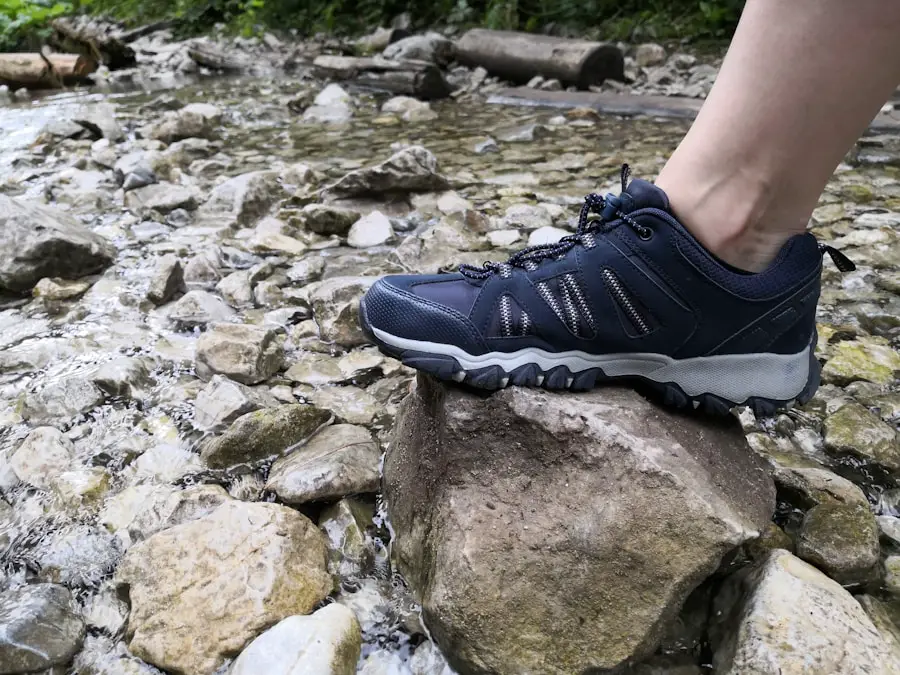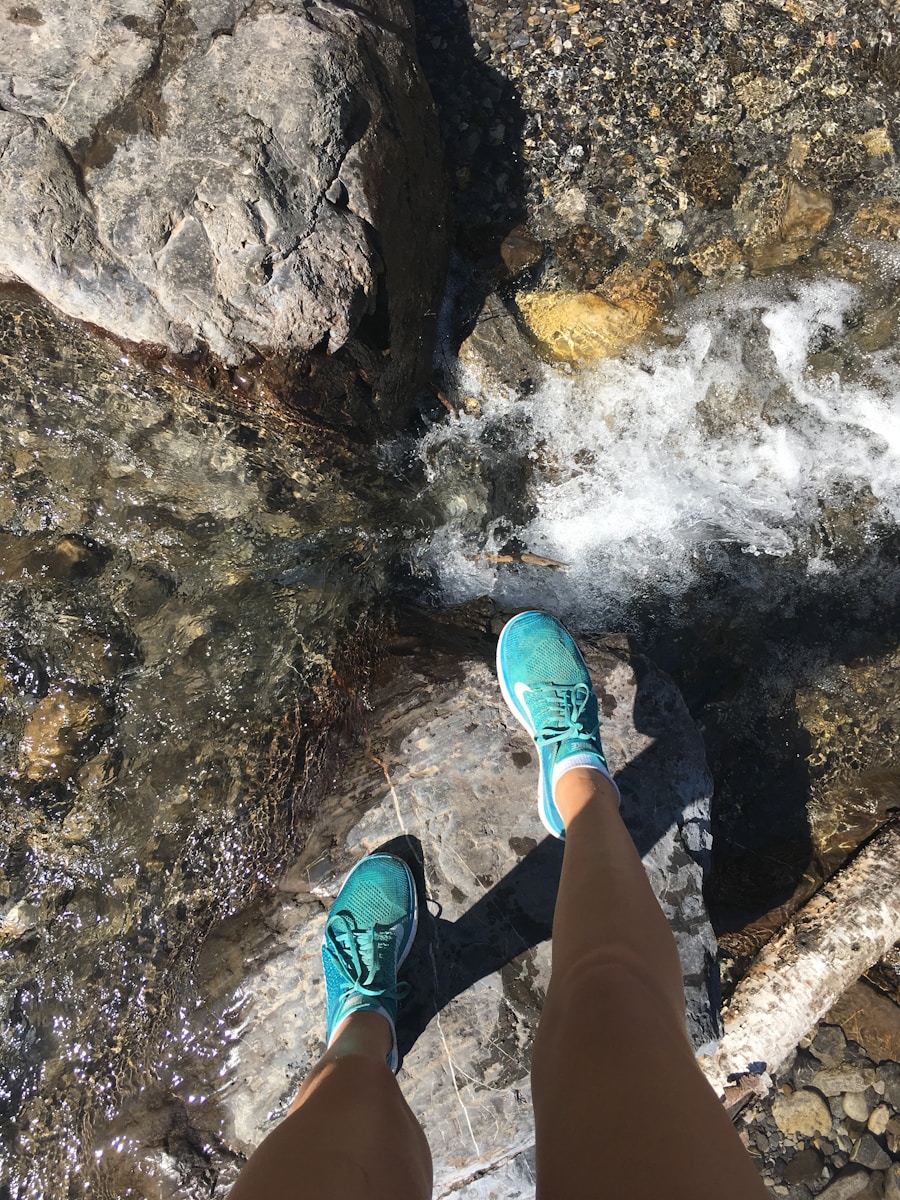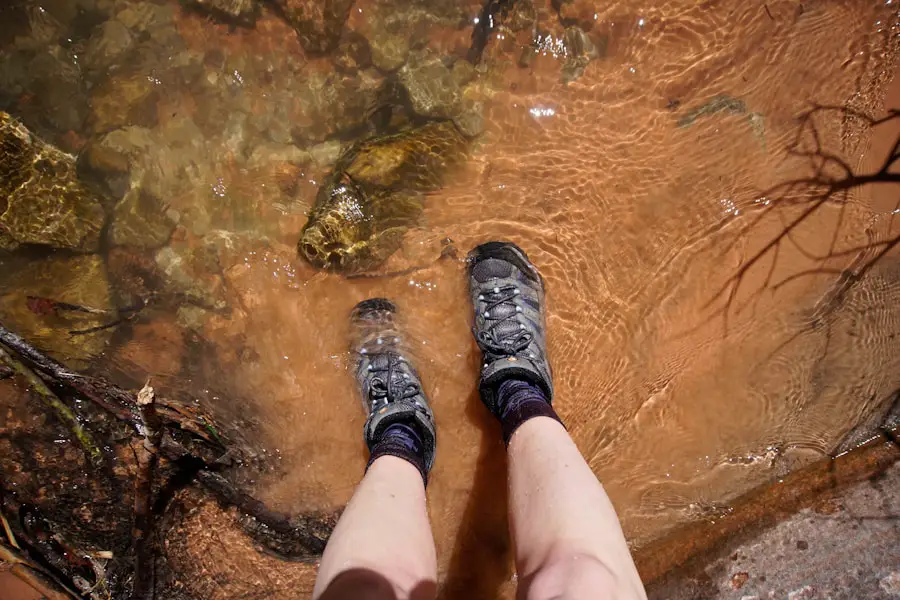Water shoes are specialized footwear designed to provide comfort and protection in wet environments. They are typically lightweight, quick-drying, and feature a design that allows for excellent drainage, making them ideal for activities that involve water, such as kayaking, paddleboarding, or beach outings. The materials used in water shoes often include mesh and synthetic fabrics that promote breathability while also being durable enough to withstand the rigors of outdoor activities.
The soles of these shoes are usually made from rubber or other non-slip materials to ensure traction on slippery surfaces, which is particularly important when navigating rocky riverbeds or wet trails. The concept of water shoes has evolved significantly over the years. Initially, they were primarily used for water sports and activities, but their versatility has led to increased popularity among hikers and outdoor enthusiasts.
As more people seek to explore nature’s beauty, the demand for footwear that can handle both wet and dry conditions has surged. This has prompted manufacturers to innovate and create designs that cater specifically to hikers who may encounter streams, puddles, or muddy trails during their adventures. Understanding the unique features and benefits of water shoes can help hikers make informed decisions about their footwear choices.
Key Takeaways
- Water shoes are designed to protect the feet and provide traction in wet and slippery conditions, making them ideal for hiking in and around water.
- Benefits of water shoes for hiking include quick-drying materials, lightweight design, and protection from sharp rocks and debris.
- Drawbacks of water shoes for hiking may include less ankle support and insulation compared to traditional hiking boots.
- Considerations for choosing water shoes for hiking include fit, traction, support, and durability.
- Tips for hiking with water shoes include wearing moisture-wicking socks, breaking them in before a long hike, and cleaning them after each use to prevent odors and deterioration.
Benefits of Water Shoes for Hiking
One of the primary benefits of water shoes for hiking is their exceptional drainage capabilities. Unlike traditional hiking boots, which can retain water and become heavy when wet, water shoes are designed with drainage holes or mesh panels that allow water to escape quickly. This feature is particularly advantageous when crossing streams or hiking in areas prone to rain, as it helps prevent the discomfort associated with soggy footwear.
Additionally, the lightweight nature of water shoes means that hikers can move more freely and with less fatigue, especially on longer treks. Another significant advantage is the breathability offered by water shoes. The materials used in their construction often allow for air circulation, which helps keep feet cool and dry even in hot weather.
This is crucial for maintaining comfort during hikes, as overheating can lead to blisters and other foot ailments. Furthermore, many water shoes come with a snug fit that provides adequate support without being overly restrictive. This balance of comfort and support is essential for hikers who need to navigate uneven terrain while ensuring their feet remain protected from sharp rocks or debris.
Drawbacks of Water Shoes for Hiking

Despite their many advantages, water shoes do have some drawbacks when it comes to hiking. One notable concern is the lack of ankle support that traditional hiking boots provide. Water shoes typically have a low-cut design, which can leave the ankles vulnerable to twists or sprains on uneven ground.
For hikers tackling rugged trails or steep inclines, this lack of support can be a significant disadvantage, potentially leading to injuries that could derail an outdoor adventure. Additionally, while water shoes excel in wet conditions, they may not offer the same level of insulation as traditional hiking footwear. In colder climates or during early spring hikes when temperatures can drop significantly, wearing water shoes may leave feet feeling chilly and uncomfortable.
The thin materials used in many water shoes do not provide adequate warmth, which can be a critical factor for hikers who plan to traverse diverse weather conditions. As a result, those considering water shoes for hiking should carefully evaluate the climate and terrain they will encounter.
Considerations for Choosing Water Shoes for Hiking
| Consideration | Description |
|---|---|
| Material | Look for water shoes made of quick-drying and breathable materials such as mesh, neoprene, or synthetic fabrics. |
| Traction | Choose water shoes with a sturdy rubber sole and good traction to prevent slipping on wet surfaces. |
| Support | Consider water shoes with arch support and cushioning for comfort during long hikes. |
| Protection | Opt for water shoes with toe guards and reinforced soles to protect your feet from rocks and debris. |
| Fit | Ensure a snug fit to prevent blisters and discomfort, but with enough room for your toes to wiggle. |
When selecting water shoes for hiking, several factors should be taken into account to ensure optimal performance and comfort. First and foremost is the fit; a well-fitting shoe is essential for preventing blisters and ensuring stability on uneven terrain. Hikers should look for shoes that offer a snug fit without being overly tight, allowing for some movement while still providing support.
Trying on different brands and styles can help identify the best fit for individual foot shapes. Another critical consideration is the sole of the water shoe. A good sole should provide adequate traction to prevent slipping on wet rocks or muddy trails.
Hikers should look for shoes with rubber outsoles featuring deep lugs or patterns designed specifically for grip in slippery conditions. Additionally, the shoe’s cushioning is important; while water shoes are generally lightweight, they should still offer enough padding to absorb shock during long hikes. Evaluating the shoe’s construction materials is also vital; durable fabrics that resist abrasions will enhance longevity and performance in rugged environments.
Tips for Hiking with Water Shoes
Hiking with water shoes requires some adjustments compared to traditional hiking footwear. One key tip is to be mindful of the terrain; while water shoes are versatile, they may not be suitable for all types of trails. Hikers should assess the conditions ahead and be prepared to adapt their route if necessary.
For instance, if a trail becomes too rocky or steep, it may be wise to switch to more supportive footwear. Another important consideration is sock choice. While many hikers prefer going sockless with water shoes for a more natural feel, wearing moisture-wicking socks can provide additional comfort and reduce the risk of blisters.
These socks help manage sweat and keep feet dry, which is especially beneficial during longer hikes. Additionally, hikers should take care to rinse off their water shoes after exposure to saltwater or muddy conditions to prevent material degradation and maintain hygiene.
Alternative Footwear Options for Hiking

While water shoes offer unique benefits for specific hiking scenarios, there are several alternative footwear options that may be more suitable depending on the conditions encountered. Traditional hiking boots are designed with ankle support and rugged soles that provide stability on uneven terrain. They are often made from waterproof materials that keep feet dry in wet conditions but may not drain as effectively as water shoes.
Trail running shoes are another popular option among hikers who prioritize lightweight footwear with good traction. These shoes typically feature breathable materials and a lower profile than traditional hiking boots, making them ideal for fast-paced hikes or running on trails. However, like water shoes, they may lack the ankle support needed for more challenging terrains.
Sandals designed for outdoor activities also present an alternative choice for warm-weather hikes. Many brands offer sandals with adjustable straps and cushioned footbeds that provide comfort while allowing for excellent ventilation. However, they may not offer the same level of protection against sharp objects as closed-toe options like water shoes or hiking boots.
Reviews of Popular Water Shoes for Hiking
Several brands have gained recognition in the market for producing high-quality water shoes suitable for hiking. One such example is the Merrell All Out Blaze Sieve Water Shoe, which combines a durable upper with a Vibram outsole designed for superior traction on wet surfaces. Users often praise its comfort and breathability, making it a popular choice among outdoor enthusiasts who frequently encounter wet conditions.
Another noteworthy option is the Keen Newport H2 Sandal, known for its robust design and excellent foot protection. With a closed-toe design and adjustable straps, this sandal offers both comfort and security during hikes that involve stream crossings or muddy trails. Reviewers appreciate its versatility, as it performs well both in water and on dry land.
The Columbia Drainmaker IV Water Shoe is also highly regarded for its lightweight construction and quick-drying capabilities. Featuring a mesh upper and a cushioned midsole, this shoe provides comfort during long hikes while ensuring efficient drainage when wet. Many users highlight its affordability without compromising quality, making it an attractive option for budget-conscious hikers.
Are Water Shoes Suitable for Hiking?
The suitability of water shoes for hiking ultimately depends on individual preferences and the specific conditions encountered on the trail. While they offer distinct advantages such as lightweight construction and excellent drainage capabilities, they may not provide the same level of support and insulation as traditional hiking footwear. Hikers must carefully consider their planned routes, weather conditions, and personal comfort needs when deciding whether to opt for water shoes.
For those who frequently hike in wet environments or enjoy activities that involve crossing streams or walking along shorelines, water shoes can be an excellent choice that enhances mobility and comfort. However, it is essential to weigh these benefits against potential drawbacks such as reduced ankle support and insulation in colder climates. By understanding the unique features of water shoes and considering personal hiking styles, individuals can make informed decisions about their footwear choices in pursuit of outdoor adventures.
If you are considering wearing water shoes for hiking, you may also be interested in learning about the best time to travel to Costa Rica. Costa Rica is a popular destination for outdoor activities, including hiking, and knowing the ideal time to visit can enhance your overall experience. Check out this article for a comprehensive guide on when to plan your trip to this beautiful country.
FAQs
What are water shoes?
Water shoes are a type of footwear designed to be worn in and around water. They are typically made of quick-drying materials and have a protective sole to provide traction and prevent slipping on wet surfaces.
Are water shoes good for hiking?
Water shoes can be suitable for hiking in certain conditions, such as when the trail involves crossing streams, walking along a shoreline, or hiking in wet and muddy terrain. They provide protection for your feet and are designed to dry quickly, making them a practical choice for water-related hiking activities.
What are the benefits of wearing water shoes for hiking?
Wearing water shoes for hiking can provide benefits such as protection from sharp rocks, shells, and other debris in the water, as well as preventing slips and falls on wet surfaces. They are also lightweight and breathable, making them comfortable for long hikes in warm weather.
Can water shoes be used for regular hiking?
While water shoes can be used for regular hiking in certain conditions, they may not provide the same level of support and stability as traditional hiking shoes or boots. It’s important to consider the terrain and potential hazards of the hike before deciding to wear water shoes.
What should I look for in water shoes for hiking?
When choosing water shoes for hiking, look for features such as a durable and protective sole, quick-drying materials, a secure fit, and good traction. It’s also important to consider the level of support and comfort provided by the shoes, especially for longer hikes.
